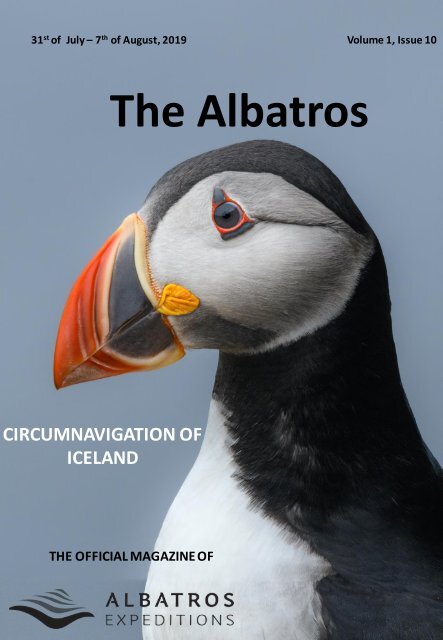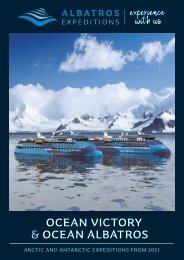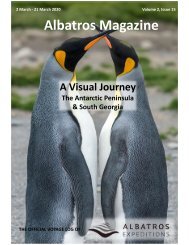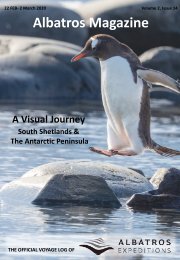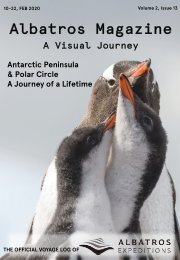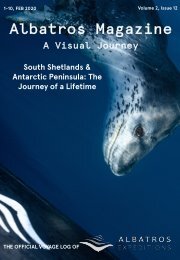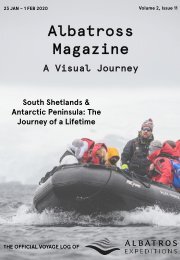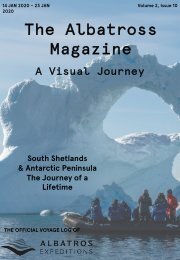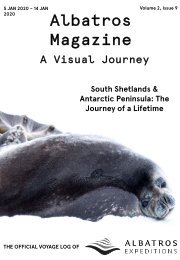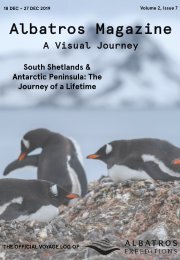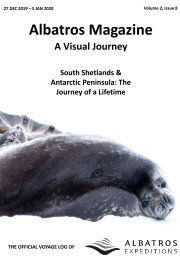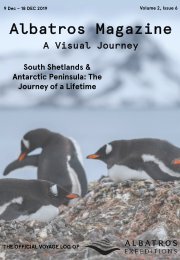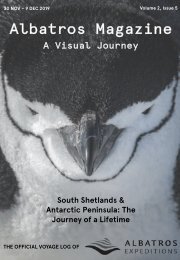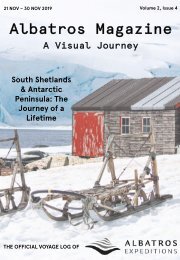Circumnavigation of Icelan - July 31 to Aug 07, 2019
You also want an ePaper? Increase the reach of your titles
YUMPU automatically turns print PDFs into web optimized ePapers that Google loves.
<strong>31</strong> st <strong>of</strong> <strong>July</strong> – 7 th <strong>of</strong> <strong>Aug</strong>ust, <strong>2019</strong><br />
Volume 1, Issue 10<br />
The Albatros<br />
CIRCUMNAVIGATION OF<br />
ICELAND<br />
THE OFFICIAL MAGAZINE OF
The Albatros<br />
Edi<strong>to</strong>r-in-Chief:<br />
Staff Writers:<br />
Layout & Design:<br />
Expedition Leader:<br />
Assistant Expedition Leader:<br />
Shop Manager:<br />
Expedition Pho<strong>to</strong>grapher:<br />
Zodiac Master:<br />
Kayak Master:<br />
Rifle Master:<br />
Expedition Guide/Lecturer:<br />
Front Cover Image:<br />
Back Cover Image:<br />
Pho<strong>to</strong>graphy Contribu<strong>to</strong>rs:<br />
Yeti (Jes Gravgaard)<br />
Steve Egan<br />
Yeti and Gaby Pilson<br />
Lars Maltha Rasmussen<br />
Barbara Post<br />
Ted Creek<br />
Nadine Smith<br />
Yuri Choufour<br />
Steve Traynor<br />
Slava Nikitin<br />
Yeti (Jes Gravgaard)<br />
Isabelle Howells<br />
Yeti Gravgaard<br />
Sara H<strong>of</strong>fritz<br />
Jon Danielson<br />
Bjørn Christensen<br />
Mikaela Von Koskull<br />
Dorte Christiansen<br />
Erna Kjartansdottir<br />
Nadia Benouddane<br />
Yuri Choufour<br />
Gaby Pilson<br />
Rena<strong>to</strong> Granieri Pho<strong>to</strong>graphy<br />
Gaby Pilson<br />
Yuri Choufour<br />
© Gaby Pilson<br />
© Yuri Choufour<br />
<strong>31</strong> <strong>July</strong> – <strong>07</strong> <strong>Aug</strong>ust , <strong>2019</strong> Volume 1, Issue 10
TABLE OF CONTENTS<br />
The Voyage<br />
By the Numbers<br />
Day 1: The Voyage Begins<br />
The Seven Sisters <strong>of</strong> Szczecin<br />
Day 2: Surtsey & Vestmannaey<br />
Puffin Facts<br />
Day 3: Djúpivogur<br />
Food For Survival<br />
Day 4: Husavìk & Grimsey<br />
Day 5: Hrisey, Akureyri & Myvatn<br />
Day 6: Hornbjarg Cliff & Vigur Island<br />
Day 7: Anarstapi<br />
A Brief His<strong>to</strong>ry <strong>of</strong> the Zodiac<br />
Day 8: Home again<br />
A Final Note<br />
4<br />
5<br />
6<br />
7<br />
8<br />
9<br />
10<br />
11<br />
12<br />
13<br />
14<br />
15<br />
16<br />
17<br />
18
The Voyage<br />
Page 4<br />
The following map traces the approximate route that the M/V Ocean Atlantic <strong>to</strong>ok during our<br />
voyage around <strong>Icelan</strong>d. You can find more information about our day <strong>to</strong> day activities, landings, and<br />
excursions on the following pages. We hope that this magazine serves as a reminder <strong>of</strong> all <strong>of</strong> the<br />
wonderful memories you made while experiencing the wonders <strong>of</strong> <strong>Icelan</strong>d with us at Albatros<br />
Expeditions.<br />
© Yuri Choufour<br />
© Yuri Choufour<br />
© Yuri Choufour<br />
<strong>31</strong> <strong>July</strong> – <strong>07</strong> <strong>Aug</strong>ust , <strong>2019</strong><br />
Volume 1, Issue 10
By the Numbers…<br />
Page 5<br />
Voyage Statistics:<br />
Northernmost Point: 66 o 34.700’N, 16 o 19.200’W<br />
Total Distance Travelled: 1017 nautical miles<br />
Numbers <strong>of</strong> guests: 119<br />
Excursion Locations:<br />
Reykjavik:<br />
Surtsey<br />
Vestmannaey<br />
Djúpivogur<br />
Grimsey<br />
Hrisey<br />
Akureyri<br />
Hornbjarg:<br />
Vigur:<br />
Anarstapi:<br />
Reykjavik:<br />
64 o 09.037’N, 21 o 51.366’W<br />
63 o 21.826’N, 20 o 22.962’W<br />
63 o 21.826’N, 20 o 22.962’W<br />
64 o 51.237’N, 14 o 28.897’W<br />
66 o <strong>31</strong>.929’N, 18 o 01.064’W<br />
65 o 58.445’N, 18 o 23.828’W<br />
65 o 42.211’N, 18 o 08.740’W<br />
66 o 29.672’N, 22 o 35.587’W<br />
66 o 02.309’N, 22 o 48.756’W<br />
64 o 45.286’N, 23 o 18.809’W<br />
64 o 09.464’N, 21 o 51.650’W<br />
© Yuri Choufour<br />
© Yuri Choufour<br />
<strong>31</strong> <strong>July</strong> – <strong>07</strong> <strong>Aug</strong>ust , <strong>2019</strong><br />
Volume 1, Issue 10
DAY 1: The Voyage Begins<br />
<strong>31</strong> st <strong>of</strong> <strong>July</strong> <strong>2019</strong> - By Steve Egan, Expedition Guide<br />
Page 6<br />
From the Voyage Log<br />
In the early hours <strong>of</strong> the morning, MV Ocean<br />
Atlantic, glided in<strong>to</strong> the safe harbour <strong>of</strong> one <strong>of</strong> the<br />
worlds most northerly <strong>of</strong> ports, Reykjavik, in <strong>Icelan</strong>d.<br />
The city’s name translates from ‘Smoke Cove’ &<br />
refers <strong>to</strong> the original sightings <strong>of</strong> haze from the<br />
thermal springs in the area. While the first<br />
settlement <strong>of</strong> the country began here well over a<br />
thousand years before <strong>to</strong>day, it is only in the last<br />
two centuries that this cosmopolitan yet relaxed<br />
city, has grown noticeably in size. Docked at an<br />
outer city port, we came alongside <strong>to</strong> a fairly<br />
deserted pier.<br />
By Sigfús Eymundsson<br />
By Johan Peter Raadsig<br />
Port days are busy & intensely organised days for<br />
the ship’s hard-working crew, & with 119 guests<br />
flying in <strong>to</strong> join us from as far afield as Asia, North<br />
America & & also many from nearby Europe, we<br />
had much <strong>to</strong> prepare <strong>to</strong> welcome them all in the<br />
best way. In warm <strong>Icelan</strong>dic summer weather, we<br />
cleaned our good ship & loaded our necessities.<br />
Soon enough our guests began <strong>to</strong> arrive from<br />
various hotels & airport transfers; it’s always an<br />
exciting time <strong>to</strong> meet new faces that would share<br />
the journey with us & with a complete<br />
circumnavigation <strong>of</strong> <strong>Icelan</strong>d ahead <strong>of</strong> us, there was<br />
much <strong>to</strong> look forward <strong>to</strong>! Aromas <strong>of</strong> c<strong>of</strong>fee & tasty<br />
snacks as we enjoyed some afternoon tea were<br />
most welcome!<br />
With formalities completed - luggage placed in<br />
cabins, passports collected for safe-keeping, those<br />
newly arrived guests wandered about our good ship,<br />
getting <strong>to</strong> know what would become home for the<br />
next week <strong>of</strong> adventures.<br />
In the Viking Theatre, a safety drill cleared us <strong>to</strong> sail<br />
away from port, Hotel Manager Oliver introduced us<br />
<strong>to</strong> the vessel & Expedition Leader Lars welcomed us<br />
<strong>to</strong> our Expedition & briefed us on the detail <strong>of</strong><br />
<strong>to</strong>morrows destination, kicking <strong>of</strong>f our exploration<br />
<strong>of</strong> this interesting country. A manda<strong>to</strong>ry safety<br />
briefing for traveling by Zodiac followed <strong>to</strong> set us up<br />
for our travel <strong>to</strong> & from the ship in comfort. It was<br />
already time for a social dinner in our Vinland<br />
restaurant, thoroughly enjoyed as MV Ocean<br />
Atlanticsailed for the horizon.<br />
After dinner nightcaps were enjoyed in the lounge<br />
or Piano Bar, it was time <strong>to</strong> rest after a long day <strong>of</strong><br />
travel & the deep sleep that comes with much<br />
excitement & warm summer sun.<br />
Let the adventures begin!<br />
© Yuri Choufour<br />
<strong>31</strong> <strong>July</strong> – <strong>07</strong> <strong>Aug</strong>ust, <strong>2019</strong> Volume 1, Issue 10
The Seven Sisters <strong>of</strong> Szczecin<br />
David MacDonald, Lecturer (Geology) & Expedition Guide<br />
M/V Ocean Atlantic was launched in 1986 as the<br />
last-built <strong>of</strong> the ‘Shoshtakovich’ class <strong>of</strong> icestrengthened<br />
passenger vessels, alongside six sister<br />
ships, <strong>to</strong>gether known as the “Seven Sisters <strong>of</strong><br />
Szczecin.<br />
Her original name was Konstantin Chernenko<br />
(Константин Черненко), after the President <strong>of</strong> the<br />
USSR (1984-1985). She was renamed Russ (Русс) in<br />
1989, and spent much <strong>of</strong> her life working in the<br />
Russian Far East.<br />
She was purchased by Albatros Expeditions and<br />
completely refitted in 2017. She is now a 200-<br />
passenger expedition vessel and is one <strong>of</strong> the<br />
strongest polar cruise ships afloat. Here are some<br />
fun facts about the “Seven Sisters”:<br />
• All seven ships were built by S<strong>to</strong>cnia Szczecinska<br />
shipyard inSzczecin, Poland between 1979-1986<br />
• Main engines: 4 x Skoda Sulzer 6LZ40 <strong>to</strong>tal power<br />
12800 kW, giving a maximum speed <strong>of</strong> 18 knots<br />
• Most <strong>of</strong> the class have one bow thruster (736 kW)<br />
and one stern thruster (426 kW); however, two<br />
ships, including ours, built in 1986, have two stern<br />
thrusters, each <strong>of</strong> 426 kW<br />
• Feature Siemens stabilisers for seaworthiness<br />
• Although built as ferries, they have a<br />
strengthened car deck for transport <strong>of</strong> tanks<br />
• Two <strong>of</strong> them had diving chambers<br />
Page 7<br />
• MV Mikhail Sholokov had hull demagnetising<br />
equipment so itcould operate inminefields<br />
• All <strong>of</strong> these ships have been scrapped except ours<br />
and Konstantin Simonov –now Ocean Endeavour<br />
Our ship has had a complex his<strong>to</strong>ry:<br />
1986-1987 In Baltictraffic, then Vladivos<strong>to</strong>k <strong>to</strong><br />
Japan & S Korea<br />
1989 renamed <strong>to</strong> Russ<br />
1997-1999 In traffic S<strong>to</strong>ckholm-Riga; 2000<br />
Odessa-Haifa; 2002 back <strong>to</strong><br />
Vladivos<strong>to</strong>k transporting cars from<br />
Japan<br />
20<strong>07</strong> Sold <strong>to</strong> Sea Ferry Shipping inMajuro<br />
and renamed 2010 <strong>to</strong> Atlantic;<br />
renovations inItaly and intraffic<br />
S<strong>to</strong>ckholm-Helsinki-St.Petersburg<br />
during summer and laid up (Oc<strong>to</strong>ber<br />
2010) inSt Petersburg<br />
2012 Sold <strong>to</strong> ISP inMiami and renamed <strong>to</strong><br />
Ocean Atlantic under Marshall<br />
Islands flag<br />
2013 Used as a hotel ship inthe German<br />
bight wind farm project<br />
2015-2017 Laid up inHelsingborg and taken <strong>to</strong><br />
Gdansk in Poland, where <strong>to</strong>tally<br />
refitted<br />
2017 Chartered <strong>to</strong> Quark Expeditions<br />
2017-present Chartered <strong>to</strong> Albatros Expeditions.<br />
© Rena<strong>to</strong> Granieri Pho<strong>to</strong>graphy<br />
<strong>31</strong> <strong>July</strong> – <strong>07</strong> <strong>Aug</strong>ust , <strong>2019</strong><br />
Volume 1, Issue 10
DAY 2: Surtsey & Vestmannaey<br />
1 st <strong>of</strong> <strong>Aug</strong>ust <strong>2019</strong> - By Yuri Choufour, Expedition Pho<strong>to</strong>grapher<br />
We began our morning with a slow sail past the<br />
famous volcanic island <strong>of</strong> Surtsey, the Westernmost<br />
island <strong>of</strong> the Westman islands archipelago <strong>of</strong> 15<br />
islands. Also holding the title <strong>of</strong> youngest island in<br />
the group, Surtsey first rose out <strong>of</strong> the sea during a<br />
volcanic eruption beginning in 1963, which lasted<br />
for almost three years. Several other islands<br />
surfaced during this eruption, but were quickly<br />
broken down by the strong Atlantic waves. Surtsey<br />
is <strong>of</strong>f limits <strong>to</strong> <strong>to</strong>urists, but scientists have performed<br />
ongoing studies <strong>of</strong> the flora and fauna, and also<br />
keep a record <strong>of</strong> the debris & garbage that washes<br />
ashore on the island.<br />
© Nadia © Yuri Benouddane<br />
Choufur<br />
Surtsey has established green patches with an array<br />
<strong>of</strong> vegetation, which is well fertilized by the large<br />
colonies <strong>of</strong> seabirds, in particular the Northern<br />
gannet. Shortly after passing Surtsey and a few<br />
more small islands, we eventually reach Heimay, the<br />
largest <strong>of</strong> them all, and home <strong>to</strong> about four<br />
thousand people. Heimaey is a powerhouse in the<br />
fishing industry, with a large chunk <strong>of</strong> the <strong>Icelan</strong>dic<br />
revenue generated there by the islands fishermen<br />
and business folks.<br />
Page 8<br />
From the Voyage Log<br />
© Yuri Choufur<br />
Tourism is growing <strong>to</strong> the island, and the daily ferry<br />
between the mainland and Heimay brings cars and<br />
<strong>to</strong>urists and is the lifeline for freight and so on. We<br />
managed <strong>to</strong> dock alongside in the port, which made<br />
landing a breeze - no wet or dry Zodiac landings<br />
<strong>to</strong>day. The passengers were split in<strong>to</strong> several<br />
groups, making long and shorter walks exploring the<br />
<strong>to</strong>wn, but all ended up in the very interesting<br />
eruption museum and received an IPOD<br />
introduction in their languages about the 1973<br />
eruption that laid a large part <strong>of</strong> the <strong>to</strong>wn <strong>to</strong> waste.<br />
© Yuri Choufur<br />
<strong>31</strong> <strong>July</strong> – <strong>07</strong> <strong>Aug</strong>ust , <strong>2019</strong><br />
© Yuri Choufur<br />
© Yuri Choufur<br />
© Yeti<br />
Several hundred houses are still buried © deep Yuri Choufur down<br />
below the enormous lava stream, which originated<br />
from a 1.3 kilometres long fissure above <strong>to</strong>wn, that<br />
eventually started flowing down <strong>to</strong>wards the <strong>to</strong>wn<br />
centre, burying one street after the other.<br />
On that fateful night in 1973, the <strong>to</strong>wns inhabitants<br />
luckily managed <strong>to</strong> escape <strong>to</strong> the mainland, as the<br />
fishing fleet had been in port due <strong>to</strong> a bad s<strong>to</strong>rm the<br />
day before. Most inhabitants eventually came back<br />
<strong>to</strong> rebuild their homes, showing the true spirit <strong>of</strong> the<br />
<strong>Icelan</strong>dic people.<br />
Volume 1, Issue 10
Puffins Facts<br />
Nadia Benouddane, Expedition Guide<br />
Page 9<br />
The puffin is <strong>Icelan</strong>d’s most iconic bird and one which both <strong>to</strong>urist and locals love <strong>to</strong> see in the wild. In the<br />
past, struggling coastal communities like <strong>Icelan</strong>d had <strong>to</strong> use all <strong>of</strong> its natural resources available for survival.<br />
This included eating these adorable little birds. While the Atlantic Puffin is now protected by legislation in<br />
other countries, <strong>Icelan</strong>d and the Faroe Islands still allow puffin hunting.<br />
1<br />
During the summer, <strong>Icelan</strong>d is the home <strong>of</strong><br />
around 10 million puffins, with the largest<br />
breeding colonies in the Westman Islands<br />
archipelago. The islands, just 10 km south <strong>of</strong><br />
the mainland, hold around 20% <strong>of</strong> the world’s<br />
Atlantic Puffin population, making it the largest<br />
puffin colony in the world. However, in recent<br />
years, the puffin colonies have started <strong>to</strong><br />
decline. This is not believed <strong>to</strong> be because <strong>of</strong><br />
habitat destruction or overhunting, but<br />
because <strong>of</strong> several failed breeding seasons.<br />
Due <strong>to</strong> dwindling numbers <strong>of</strong> birds, temporary<br />
restrictions on hunting have been made <strong>to</strong><br />
protect the species.<br />
3<br />
There are four species <strong>of</strong> puffins, three <strong>of</strong> them<br />
are appearing quite similar. The Atlantic and<br />
the Horned Puffin look alike, with the<br />
exception <strong>of</strong> a blue-grey triangle at the base <strong>of</strong><br />
the Atlantic puffin’s beak and the horn puffin<br />
has a horns pointing out fro the eyes. During<br />
the breeding season, straw-like golden<br />
coloured feathers protrude from the crown <strong>of</strong><br />
the tufted puffin’s head and the body is<br />
entirely black. The fourth species, the<br />
rhinoceros auklet, doesn’t look like the other<br />
three – it’s ashen coloured, with a rhino-like<br />
protrusion during the breeding season. But it’s<br />
still technically a puffin.<br />
2<br />
Puffins<br />
are called several names based on their<br />
appearance. Puffin is thought <strong>to</strong> come from the<br />
word puff, meaning swollen, because the fluffy<br />
pufflings do appear rather round. Puffins have<br />
also been referred <strong>to</strong> as the clowns <strong>of</strong> the<br />
ocean or sea parrots. These last ones spend<br />
most <strong>of</strong> their life out in the sea where just<br />
before winter they shed the outer layer <strong>of</strong> their<br />
beak, leaving them smaller and duller. When<br />
spring arrives, though, their beaks return <strong>to</strong><br />
their bright form, just intime for mating season<br />
© Yuri Choufour<br />
© Yuri Choufour<br />
4<br />
When starting a puffin family, our feathered<br />
friends dig out a burrow using their sharp<br />
claws and beak, usually in a grassy bank or<br />
rocky crevice. At the back <strong>of</strong> their burrow<br />
home, they build a nest lined with feathers<br />
and grass where the female lays a single egg.<br />
Both parents take it in turn <strong>to</strong> incubate the<br />
egg for the next 36-45 days before the baby<br />
“puffling” hatches. The young will follow the<br />
parents <strong>to</strong> the sea and will only return <strong>to</strong> the<br />
colony when it reaches the maturity <strong>to</strong> breed<br />
at the age <strong>of</strong> five.<br />
<strong>31</strong> <strong>July</strong> – <strong>07</strong> <strong>Aug</strong>ust , <strong>2019</strong><br />
Volume 1, Issue 10
DAY 3: Djúpivogur<br />
2 nd <strong>of</strong> <strong>Aug</strong>ust <strong>2019</strong> – By Sara E. H<strong>of</strong>fritz, Expedition Guide From the Voyage Log<br />
Page 10<br />
© Yeti<br />
The excursions <strong>to</strong>day <strong>of</strong>fered something for the bird<br />
lovers, something for the rock lovers and something<br />
for the nature lovers. We reached the small harbour<br />
in Djúpivogur by zodiacs which was the starting<br />
point <strong>of</strong> the day’s different excursions.<br />
The first group boarded a convoy <strong>of</strong> huge 4x4 jeeps<br />
and set <strong>of</strong>f for a <strong>to</strong>ur <strong>to</strong> visit the H<strong>of</strong>felsjökull<br />
Glacier. The H<strong>of</strong>felsjökull Glacier is one <strong>of</strong> the outlet<br />
glaciers merging down from the large Vatnajökull Ice<br />
Cap. It was formed during the<br />
©<br />
little<br />
Yuri<br />
Ice<br />
Choufour<br />
Age, which<br />
began around the 1450, but it is now retreating. This<br />
retreat has resulted in a pro-glacial lake between<br />
the glacier front and the old terminal moraine,<br />
where numerous small blocks <strong>of</strong> ice float around in<br />
the murky water.<br />
The second group spent the morning in Djúpivogur<br />
with our local guides Jón and Erna, who gave an<br />
insight in<strong>to</strong> the local his<strong>to</strong>ry <strong>of</strong> this charming village<br />
where trading dates back <strong>to</strong> 1589 and where fishing<br />
isthe main industry.<br />
On the local trip around the village the group also<br />
visited the workshop that hosts the Mineral<br />
Collection <strong>of</strong> Auðunn, where stunning, polished<br />
rocks from the local area cover the walls.<br />
© Yuri Choufour<br />
© Yuri Choufour<br />
© Yeti<br />
The third group went on a scenic route around the<br />
wetlands <strong>of</strong> Djúpivogur with Yeti and Lars <strong>to</strong> observe<br />
the wonderful birdlife in their natural environment.<br />
Almost 50 different bird species were spotted this<br />
day; specialy the Islandic Black-tailed Godwit.<br />
Both the birdlife and landscape around Djúpivogur<br />
have a great variety. The mountains surrounding the<br />
fjord consist <strong>of</strong> layers upon layers <strong>of</strong> basaltic lava<br />
that was formed 3 million years ago. This includes<br />
the beautiful pyramid-shaped mountain,<br />
Búlandstindur, which is the highest peak in <strong>Icelan</strong>d<br />
rising directly from the sea.<br />
Once everyone was back on the ship Slava and Steve<br />
gave an introduction for those interested in using<br />
our onboard kayaks.<br />
As we sailed northwards <strong>to</strong> our next s<strong>to</strong>p at Grímsey<br />
and the Arctic Circle, many <strong>of</strong> us <strong>to</strong>ok the<br />
opportunity <strong>to</strong> go out on deck and enjoy the setting<br />
sun.<br />
© Yuri Choufour<br />
© Yuri Choufour © Bjørn Christensen<br />
© Yeti<br />
<strong>31</strong> <strong>July</strong> – <strong>07</strong> <strong>Aug</strong>ust , <strong>2019</strong><br />
Volume 1, Issue 10
Food For Survival<br />
Nadia Benouddane , Expedition Guide<br />
Page 11<br />
In the past, resources in <strong>Icelan</strong>d were few and far between; the lack <strong>of</strong> sunlight severely limited fishing<br />
and hunting options. Therefore, for centuries <strong>Icelan</strong>ders had <strong>to</strong> smoke, pickle or dry their food in order<br />
<strong>to</strong> preserve it through the harsh winters. As a result, traditional <strong>Icelan</strong>dic food mainly consists <strong>of</strong> fish,<br />
seafood and lamb that's gone through some kind <strong>of</strong> preservation method.<br />
© web source<br />
But surrounding <strong>Icelan</strong>d is the bountiful North<br />
Atlantic Ocean, and as an island nation, nothing has<br />
been more vital <strong>to</strong> this people's survival than fishing.<br />
It was not only <strong>to</strong> put food on the <strong>Icelan</strong>dic table<br />
but also fish export helped transform the country<br />
from one <strong>of</strong> the poorest in Europe at the beginning<br />
<strong>of</strong> the 19th century <strong>to</strong> one <strong>of</strong> the richest <strong>to</strong>day. In<br />
the early days <strong>Icelan</strong>ders instead <strong>of</strong> eating a piece <strong>of</strong><br />
bread with a meal, as was the cus<strong>to</strong>m in<br />
neighbouring countries, <strong>Icelan</strong>ders ate dried<br />
s<strong>to</strong>ckfish. Although it is not eaten quite as much<br />
<strong>to</strong>day, s<strong>to</strong>ckfish known as Harðfiskur remains one <strong>of</strong><br />
the most popular dishes <strong>of</strong> the old <strong>Icelan</strong>dic<br />
tradition.<br />
© web source<br />
Along with the fish, sheep have been the lifeblood<br />
<strong>of</strong> this nation since its arrival with the Vikings. Its<br />
wool has kept the nation warm, and its meat has<br />
helped keep them alive through severe climate<br />
conditions. Though famous for its wool used in<br />
‘lopapeysa’ woolly sweater, the <strong>Icelan</strong>dic sheep is<br />
mainly farmed for its meat. Each spring, the sheep<br />
are let out <strong>of</strong> their pen <strong>to</strong> roam freely around the<br />
countryside, spending the whole summer grazing in<br />
the pesticide-free wilderness.<br />
Since the climate prevents the growth <strong>of</strong> grain, the<br />
sheep live on grass, angelica, berries and seaweed.<br />
© web source<br />
The <strong>Icelan</strong>ders did not only cure, dry or smoke their<br />
food, they have also made good use <strong>of</strong> the<br />
geothermal energy <strong>to</strong> bake the unique <strong>to</strong> the<br />
country ‘Lava baked bread ’ which is still made in<br />
the same manners it has been done the last 100<br />
years. This lava baked rye bread is very popular in<br />
the country. It's a dark bread, that's got a particular<br />
taste and that is slightly sweet.<br />
Nonetheless, it's not a pastry and is mostly eaten on<br />
its own with butter, accompanying fish or hung and<br />
smoked lamb ’hangikjöt’<br />
With new times come new technologies and knowledge. <strong>Icelan</strong>ders have learnt <strong>to</strong> utilise the natural<br />
surroundings, especially in regards <strong>to</strong> geothermal energy and travels abroad brought all kinds <strong>of</strong> ideas<br />
which, combined with traditional ingredients, created some incredible fusions <strong>of</strong> flavours. In Reykjavík<br />
City, you’ll find a plethora <strong>of</strong> multi-cultural restaurants as well as a large local food scene in style with<br />
the New Nordic Cuisine movementwhere the emphasis ison purity, simplicity and freshness.<br />
<strong>31</strong> <strong>July</strong> – <strong>07</strong> <strong>Aug</strong>ust , <strong>2019</strong><br />
Volume 1, Issue 10
DAY 4: Husavìk & Grimsey<br />
3 rd <strong>of</strong> <strong>Aug</strong>ust <strong>2019</strong> – By Isabelle Howells, Expedition Guide<br />
Page 12<br />
From the Voyage Log<br />
In the afternoon, Isabelle held a lecture in the<br />
theatre, and had a lot <strong>to</strong> talk about <strong>to</strong> cover the<br />
exciting wildlife experiences <strong>of</strong> the last days. Puffins<br />
were discussed, and we learnt about Skjalfandi bay,<br />
situated just south <strong>of</strong> Grimsey on the coast <strong>of</strong><br />
<strong>Icelan</strong>d. This bay is renowned for being one <strong>of</strong> the<br />
best feeding areas for whales in this part <strong>of</strong> the<br />
world, and known as being a rare place where itis<br />
© Yuri Choufour<br />
© Yuri Choufour<br />
As we anchored <strong>of</strong>f Grimsey on Saturday morning,<br />
we could admire this wedge-shaped island before<br />
the fog descended and blanketed the land. With the<br />
arctic circle cutting through the northern most<br />
point, this curious land mass is the only part <strong>of</strong><br />
<strong>Icelan</strong>d <strong>to</strong> be considered in the Arctic. Many <strong>of</strong> us<br />
trekked the length <strong>of</strong> the island <strong>to</strong> what was for<br />
some <strong>of</strong> us, the furthest north we’ve ever travelled.<br />
Grimsey, which is inhabited year-round by families<br />
involved mostly in the fishing industry, also benefits<br />
from the visi<strong>to</strong>rs it received by ferry and cruise<br />
ships. With no preda<strong>to</strong>rs such as Arctic foxes on the<br />
island, Grimsey is a true paradise for birds. We were<br />
lucky enough <strong>to</strong> see scores <strong>of</strong> nesting puffins and<br />
swooping arcticturns looking out for their young.<br />
© Yuri Choufour<br />
© Gaby Pilson<br />
© James Floyd<br />
© Yuri Choufour<br />
possible <strong>to</strong> see blue whales so close <strong>to</strong> shore, at<br />
certain times <strong>of</strong> the year. Just as we were learning<br />
about whale identification, an announcement came<br />
that there were dolphins and a humpback whale <strong>to</strong><br />
be seen outside!<br />
After a couple <strong>of</strong> hours <strong>of</strong> admiring humpbacks<br />
around the ship, we headed a little further south <strong>to</strong><br />
observe the fantastic coastline between Skjalfandi<br />
bay and Eyjafjörður. That evening’s briefing was<br />
accompanied by Mikaela’s recap about the Arctic<br />
Circle. The busy day was <strong>to</strong>pped <strong>of</strong>f with a quiz<br />
hosted by Fredrik, our expert on all things <strong>Icelan</strong>d<br />
related.<br />
© Yeti<br />
After lunch back onboard Ocean Atlantic, it was time<br />
for the Polar Plunge! We stayed anchored in order<br />
<strong>to</strong> be as close <strong>to</strong> the Arctic Circle as possible and<br />
many brave guests donned their swimsuits and leapt<br />
<strong>of</strong>f the gangway and in<strong>to</strong> the bitterly cold water.<br />
People warmed up quickly once out with a dry <strong>to</strong>wel<br />
and a vodka shot!<br />
© Yuri Choufour<br />
<strong>31</strong> <strong>July</strong> – <strong>07</strong> <strong>Aug</strong>ust , <strong>2019</strong><br />
Volume 1, Issue 10
DAY 5: Hrisey, Akureyri & Myvatn<br />
4 th <strong>of</strong> <strong>Aug</strong>ust <strong>2019</strong> – By Mikaela von Koskull , Expedition Guide<br />
From the Voyage Log<br />
In perfectly calm conditions, but under an overcast<br />
sky we landed by zodiacs on Hrisey Island. Soon<br />
after the landing, the party split in<strong>to</strong> various<br />
groups; first group went on a short hike around the<br />
village and the second group joined the long hike<br />
and birdwatch <strong>to</strong>ur around the island. Our local<br />
guide introduced the island his<strong>to</strong>ry on a short<br />
briefing once we reached the village and while<br />
walking, we came across many <strong>of</strong> the island<br />
plants, flowers and birds. Hrisey is home <strong>to</strong> over 40<br />
species <strong>of</strong> birds, such as the Ptarmigan, the Merlin<br />
Falcon and the Redpol.<br />
© Yuri Choufour<br />
Page 13<br />
© Yuri Choufour<br />
Shortly after our return by zodiac <strong>to</strong> the ship, M/V<br />
Ocean Atlantic set sail <strong>to</strong>ward our next destination,<br />
Akureyri Harbor where our excursion busses and<br />
local guides were waiting for us <strong>to</strong> lead us during<br />
our afternoon excursion. Through bus ride and<br />
<strong>Icelan</strong>dic tails we made our way <strong>to</strong> the<br />
spectacular Godafoss where the water <strong>of</strong> the<br />
Skjalfandafljot river falls from a height <strong>of</strong> 12 meters<br />
over a width <strong>of</strong> 30 meters. There we enjoyed 40<br />
minutes free walk along the site.<br />
We then came back <strong>to</strong> our bus and drove <strong>to</strong>ward<br />
the beautiful lake Myvatn. On arrival we were<br />
welcomed with a fresh Toma<strong>to</strong> soup and right after<br />
regaining some energy we continued our excursion<br />
<strong>to</strong> the lake sighting areas. Myvatn is a shallow<br />
eutrophic lake <strong>of</strong> active volcanism in the north <strong>of</strong><br />
<strong>Icelan</strong>d, it was created 2300 years ago by a large<br />
basaltic lava eruption. The lake is fed by nutrientrich<br />
spring water and has a high abundance <strong>of</strong><br />
aquatic insects that form an attractive food supply<br />
and home <strong>to</strong> 13 duck and other bird species.<br />
Soon after, we walked further <strong>to</strong> the dramatic<br />
structures <strong>of</strong> Dimmuborgir where we spent some<br />
time sightseeing the area. We finished our day<br />
adventures by visiting the Namafjall geothermal<br />
area which is also known as Hverir thermal baths.<br />
There we observed the many smoking fumaroles<br />
and boiling mud pots before our adventure in<br />
Myvatn area ended and we headed back through<br />
the new, 7 kilometer long tunnel <strong>to</strong> the harbor and<br />
<strong>to</strong> the waiting ship. As we sat down for yet another<br />
dinner in the Vinland restaurant, M/V Ocean<br />
Atlantic slowly made her way out the fjord, <strong>to</strong>wards<br />
open waters and new adventures.<br />
© Yuri Choufour<br />
<strong>31</strong> <strong>July</strong> – <strong>07</strong> <strong>Aug</strong>ust , <strong>2019</strong><br />
Volume 1, Issue 10
DAY 6: Hornbjarg Cliff & Vigur Island<br />
5 th <strong>of</strong> <strong>Aug</strong>ust <strong>2019</strong> - By Dorte A. Christiansen, Hiking Master<br />
From the Voyage Log<br />
The morning started with a very early sailing beside<br />
the steep Hornbjarg sea mounts, covered in<br />
romantic mist. Most <strong>of</strong> the guillemots had left their<br />
nest on the steep cliff, but some were still moving<br />
around on the waves. The ocean was rather calm<br />
and eventually the sun showed her warm rays and<br />
made the stay outside on deck a great experience.<br />
The ships hotel staff treated us with an excellent<br />
Barbeque buffet on the aft deck.<br />
Page 14<br />
© Yuri Choufour<br />
© Yeti<br />
An hour later, we sailed in<strong>to</strong> the fjord and anchored<br />
opposite the village <strong>of</strong> Súðavík on the southern part<br />
<strong>of</strong> the island Vigur. Vigur means a spearhead due <strong>to</strong><br />
the shape <strong>of</strong> the island, with a sharp point. Zodiacs<br />
with a dry landing <strong>to</strong>ok place in this wonderful island<br />
where the four groups landing were staggered in<br />
order <strong>to</strong> facilitate the work <strong>of</strong> the local guides, who<br />
are from the family living on the island. The fifth<br />
group who had been on the kayak activity <strong>of</strong>fered<br />
by our Kayak Master Slava and Steve also joined the<br />
island later <strong>to</strong> enjoy the splendid view on the fjord.<br />
©Yeti<br />
The walk started at the Eider down workshop<br />
located just next <strong>to</strong> the oldest seaworthy boat in<br />
<strong>Icelan</strong>d. The ship being 200 years old, was used<br />
recently <strong>to</strong> ship out the last 70 sheep from the<br />
island <strong>to</strong> the mainland. Tourists are now the new<br />
“sheep” on the island and provide an income for the<br />
inhabitants. The down from the eiders is mainly<br />
exported <strong>to</strong> Japan where it is used for down<br />
comforters, selling at very high prices. There are<br />
3.600 eiders nesting and they produce about 60<br />
kilos <strong>of</strong> eider down annually.<br />
We later walked <strong>to</strong>ward the windmill, where while<br />
facing the fjord a fur seal appeared on the surface<br />
on the water and by further observation we noticed<br />
another one resting on the beach.<br />
During our walk around the island, apart from the<br />
big artic tern colony we were fortunate <strong>to</strong> see<br />
ravens, puffins, black guillemots and a few Gyr<br />
Falcons roaming above us. Terns tried <strong>to</strong> protect<br />
their nests by flying close <strong>to</strong> our heads, so in order<br />
<strong>to</strong> keep them afar we all had sticks <strong>to</strong> hold up in<strong>to</strong><br />
the air. At the end <strong>of</strong> our walk we were invited in<strong>to</strong><br />
the owner's cafe indulging in rhubarb pie, date<br />
bread and home baked bread as well as a delicious<br />
cup <strong>of</strong> tea and c<strong>of</strong>fee.<br />
The weather could not have been better <strong>to</strong>day and<br />
engulfed in sunshine we were shuttled back on<br />
board. We got the amazing show <strong>of</strong> 2 or 3<br />
humpback whales showing their fluke many times<br />
and several breaching. A perfect end <strong>to</strong> a perfect<br />
day.<br />
<strong>31</strong> <strong>July</strong> – <strong>07</strong> <strong>Aug</strong>ust , <strong>2019</strong><br />
Volume 1, Issue 10
DAY 7: Arnarstapi<br />
6 th <strong>of</strong> <strong>Aug</strong>ust <strong>2019</strong> – By Bjørn Christensen, Expedition Guide<br />
Page 15<br />
From the Voyage Log<br />
In the forecast for <strong>to</strong>day strong winds around Flatey<br />
were predicted. Previous attempts <strong>to</strong> visit the island<br />
under such conditions have failed, therefore it was<br />
instead decided <strong>to</strong> call at the village <strong>of</strong> Arnarstapi<br />
situated on the south side <strong>of</strong> the western part <strong>of</strong> the<br />
Snefællsnes peninsula.<br />
Arnastapi, also just known as Stapi, is a small fishing<br />
village at the foot <strong>of</strong> Mt. Stapafell. Just below the<br />
magnificient Snefælls Jökul.<br />
Snefælls Jökull was the entry point <strong>to</strong> the interior <strong>of</strong><br />
the planet for the characters in Jules Verne's ”A<br />
Journey <strong>to</strong> the Centre <strong>of</strong> the Earth”. It is also known<br />
as the resting place <strong>of</strong> Bárður, the half human half<br />
org, described inthe <strong>Icelan</strong>dic Sagas.<br />
© Yuri Choufur<br />
Pho<strong>to</strong><br />
©Yuri Choufour<br />
©Yuri Choufour<br />
Pho<strong>to</strong><br />
After anchoring at 8 o'clock, a wet landing was<br />
announced, however we barely got our boots wet<br />
when disembarking the zodiacs by turning over the<br />
edge, stepping on <strong>to</strong> the yellow box and walking up<br />
the blue carpet rolled out for us.<br />
The clouds lifted, and we could enjoy calm and<br />
sunny weather, during the whole visit.<br />
Three different walks were <strong>of</strong>fered. A long walk over<br />
the lava fields <strong>to</strong> the nearby village <strong>of</strong> Hellnar, a<br />
shorter walk, and one for the ”birdies”.<br />
Coming up from the harbor we could see the giant<br />
sculpture <strong>of</strong> the half human half org Bárður<br />
overlooking his terri<strong>to</strong>ry.<br />
We were greeted by hundreds <strong>of</strong> arctic terns<br />
aggressively protecting and feeding their chicks. The<br />
kittiwakes screaming their name out was the sound<br />
carpet for the visit <strong>to</strong> this pearl <strong>of</strong> Snefællsnæs.<br />
©Yuri Choufour<br />
© Yuri Choufour<br />
©Sara H<strong>of</strong>fritz<br />
© Yuri Choufur © Yeti<br />
<strong>31</strong> <strong>July</strong> – <strong>07</strong> <strong>Aug</strong>ust , <strong>2019</strong><br />
Volume 1, Issue 10
A Brief His<strong>to</strong>ry <strong>of</strong> the Zodiac<br />
Steve Traynor, Zodiac Master<br />
Page 16<br />
In expedition cruising, the most important <strong>to</strong>ol we use is the Zodiac inflatable boat. These manoeuvrable,<br />
reliable, robust vessels are the workhorse <strong>of</strong> the expedition cruise industry, from the north <strong>of</strong> Svalbard <strong>to</strong><br />
the southern end <strong>of</strong> the Antarctic Peninsula. They have a long his<strong>to</strong>ry – as you can see from the stages<br />
below, many differentinventions needed <strong>to</strong> come <strong>to</strong>gether <strong>to</strong> create the craft we use <strong>to</strong>day.<br />
© Rena<strong>to</strong> Granieri Pho<strong>to</strong>graphy<br />
1838 Charles Goodyear (USA) discovered the process for vulcanising rubber (a US patent was granted<br />
in 1844) – this process is used for hardening and strengthening rubber.<br />
1843 Goodyear’s process was s<strong>to</strong>len by Thomas Hancock (UK) using the process <strong>of</strong> reverse<br />
engineering; less controversially, Hancock invented the “mastica<strong>to</strong>r” –a machine for re-using<br />
rubber scraps – this made the rubber industry much more efficient.<br />
1845 The first successful inflatable boat (Halkett boat) was designed by Lieutenant Peter Halkett<br />
(UK), specifically for Arctic operations. Halkett Boats were used by the Orcadian explorer, John<br />
Rae, in his successful expedition <strong>to</strong> discover the fate <strong>of</strong> the Franklin Expedition.<br />
1866 Four men made the first crossing <strong>of</strong> the Atlantic Ocean from New York <strong>to</strong> Britain on a three -<br />
tube inflatable raft.<br />
1896 The original Zodiac company was founded by Maurice Mallet (France) <strong>to</strong> produce airships.<br />
1909 The first outboard mo<strong>to</strong>r was invented by Ole Evinrude in Milwaukee, Wisconsin.<br />
1912 The loss <strong>of</strong> the Titanic and subsequent shipping losses during World War 1 proved the need for<br />
inflatable rafts for use as supplementary lifeboats.<br />
1919 RFD firm (UK) and the Zodiac company (France) started building inflatable boats.<br />
1934 The airship company, Zodiac, invented the inflatable kayak and catamaran<br />
1942 The Marine Raiders – an elite unit <strong>of</strong> the US Marine Corps – used inflatable boats <strong>to</strong> carry out<br />
raids and landings in the Pacific theatre.<br />
1950 Alain Bombard first combined the outboard engine, a rigid floor and an inflatable boat (built by<br />
the Zodiac company).<br />
1952 Alain Bombard crossed the Atlantic Ocean with his inflatable; after this, his good friend, the<br />
famous diver Jacques-Yves Cousteau, started using them.<br />
1960 Zodiac licensed production <strong>to</strong> a dozen companies in other countries because <strong>of</strong> their lack <strong>of</strong><br />
manufacturing capacity in France.<br />
<strong>31</strong> <strong>July</strong> – <strong>07</strong> <strong>Aug</strong>ust , <strong>2019</strong><br />
Volume 1, Issue 10
DAY 8: Home Again<br />
7 th <strong>of</strong> <strong>Aug</strong>ust <strong>2019</strong> – Reykjavik From the Voyage Log<br />
Page 17<br />
After last night’s end-<strong>of</strong>-voyage festivities, we<br />
awoke much <strong>to</strong>o early for our final morning on the<br />
Ocean Atlantic. As the Ocean Atlantic pulled in<strong>to</strong> its<br />
anchorage in Reykjavik, we started the process <strong>of</strong><br />
leaving behind the ship and the people we’ve come<br />
<strong>to</strong> know so well over the past 7 days.<br />
Our bags were packed and s<strong>to</strong>wed in the corridors,<br />
ready for our early-morning busses and flights back<br />
<strong>to</strong> S<strong>to</strong>ckholm, and everywhere in between. After 7<br />
whole days immersed in the landscapes and<br />
amongst the wildlife <strong>of</strong> the Arctic, it was time <strong>to</strong><br />
return home or <strong>to</strong> wherever our life’s journeys<br />
bring us.<br />
And so – farewell, adieu, and goodbye. Together we<br />
have visited an incredible and vast wilderness. We<br />
have experienced magnificent mountain vistas and<br />
felt the power <strong>of</strong> the elements and seen how<br />
quickly they can change. We enjoyed wonder food<br />
and comfortable surroundings aboard the Ocean<br />
Atlantic.<br />
We have boarded zodiacs and cruised through<br />
fjords around the land <strong>of</strong> ice and fire. We have<br />
shared unique moments, held engaging<br />
conversations, and laughed <strong>to</strong>gether over beers<br />
and c<strong>of</strong>fees. We’ve made new friends and<br />
experienced the power <strong>of</strong> expeditionary travel.<br />
We hope the expedition team has helped make this<br />
the trip <strong>of</strong> a lifetime - one that will persist in your<br />
memories for weeks, months, and years, <strong>to</strong> come.<br />
Although we must say good-bye <strong>to</strong> these places we<br />
have come <strong>to</strong> know and love, it is a fond farewell as<br />
we are all true ambassadors for the Arctic and all<br />
the beauty itholds.<br />
On behalf <strong>of</strong> Albatros Expeditions, our captain and<br />
crew, the expedition team, and everyone else who<br />
helped make this journey a resounding success, it<br />
has been a pleasure travelling with you.<br />
We hope that you will come back and experience<br />
these wonderful places with us once again!<br />
Team Group pho<strong>to</strong><br />
© Yuri Coufour<br />
© Yuri Choufour<br />
©Yuri Choufour<br />
<strong>31</strong> <strong>July</strong> – <strong>07</strong> <strong>Aug</strong>ust , <strong>2019</strong><br />
Volume 1, Issue 10
A Final Note…<br />
Page 18<br />
As any good expedition comes <strong>to</strong> a close, many <strong>of</strong> us experience the<br />
effervescent excitement that comes when we immerse ourselves<br />
completely in an adventure. Although we all came in<strong>to</strong> this voyage with<br />
our own expectations and personal motivations, on the ship, we quickly<br />
learned that the best plan is the one that we end up doing.<br />
While weather and the landscape<br />
can conspire against us in the<br />
northern latitudes, the right mindset<br />
can make all <strong>of</strong> the difference.<br />
Wind, rain, sleet, and snow make<br />
no difference when we come<br />
prepared for an adventure and all<br />
the excitement it holds. Whether<br />
you saw what you came for or you<br />
experienced something else<br />
entirely, when you set out on an<br />
expedition, you come for the<br />
mountains and the wildlife, but<br />
stay for people and places you<br />
meet along the way.<br />
Although we all eventually have <strong>to</strong><br />
leave behind our beloved Ocean<br />
Atlantic, there are always a few<br />
things we can take home from an<br />
expedition:<br />
• An acceptance and<br />
embracement <strong>of</strong> adversity and<br />
uncertainty when the natural<br />
world alters our plans.<br />
• A fondness for the wild and a<br />
strong desire <strong>to</strong> keep remote<br />
natural locations as beautiful<br />
and free as they can be.<br />
• An insatiable interest in learning<br />
more about the people, places,<br />
and cultures in some <strong>of</strong> the<br />
most remote parts <strong>of</strong> the world.<br />
As you unpack you bags, you may<br />
find souvenirs and keepsakes from<br />
your journey. Your camera may be<br />
filled with countless pho<strong>to</strong>s,<br />
however blurry, <strong>of</strong> the many<br />
animals and mountains that have<br />
crossed our paths. At the end <strong>of</strong><br />
the day, however, what matters<br />
most is the experience <strong>of</strong>, the<br />
journey <strong>to</strong>, and the memories <strong>of</strong><br />
these wild and wonderful places.<br />
Best wishes from all <strong>of</strong> us on the<br />
expedition team as you continue<br />
on with your adventures!<br />
Lars Maltha Rasmussen<br />
Expedition Leader<br />
Barbara Post<br />
Assistant Expedition Leader<br />
Thank you for experiencing the Arctic with us at Albatros<br />
Expeditions. We hope <strong>to</strong> see you aboard the Ocean Atlantic<br />
again in the future!<br />
Ted Creek<br />
Assistant Expedition Leader<br />
<strong>31</strong> <strong>July</strong> – <strong>07</strong> <strong>Aug</strong>ust, <strong>2019</strong><br />
Volume 1, Issue 10


